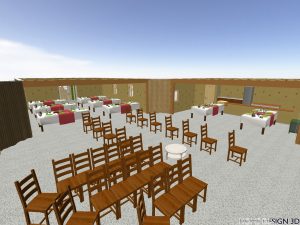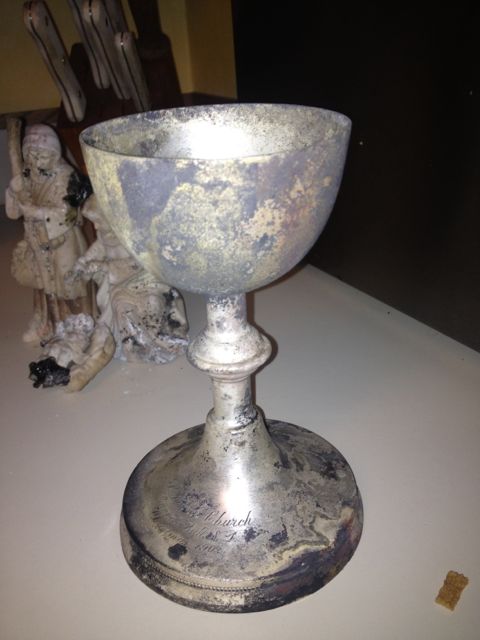Rebuilding fund underway for St. James, Cannon Ball, ND
 The timing was only happenstance. An arsonist set fire to St. James in Cannon Ball on the night of July 25, a major feast day in the Episcopal Church commemorating St. James, the apostle. The small building on the Standing Rock Indian Reservation burnt to the ground, leaving a silver chalice—given to the church more than 100 years ago—as the only salvageable item.
The timing was only happenstance. An arsonist set fire to St. James in Cannon Ball on the night of July 25, a major feast day in the Episcopal Church commemorating St. James, the apostle. The small building on the Standing Rock Indian Reservation burnt to the ground, leaving a silver chalice—given to the church more than 100 years ago—as the only salvageable item.
But it seemed ordained that more than a building caught fire that night. The raging fire that destroyed the church also lit a flame in the hearts of parishioners, many of whose involvement with St. James had become minimal.
“So far this has been a life-giving challenge,” said the Rev. Canon John Floberg, a deputy from the Diocese of North Dakota who is rector of St. James and canon missioner for native ministry in the diocese.
On All Saints Day, Floberg and about 20 St. James parishioners kicked off a $90,000 fundraising campaign to rebuild St. James. Former President of the House of Deputies Bonnie Anderson is the honorary chair of the Ikpanazin Rebuilding Fund (Ikpanazin is a Dakota word that describes someone picking themselves up from the ground). Floberg said that during the first few weeks of the campaign almost $10,000 was donated which, including insurance and other donations, brings the total amount collected to about $388,000.
Donations have ranged from $5 to $3,000, with most of the larger contributions coming from congregations.
“Yesterday I got a call from All Saints Church in Pratt, Kansas,” Floberg said. “It’s a small congregation that saw the fundraising mailing and has pledged $2500; they chose to build the bell tower.”
Lots of smaller contributions have been in the $10, $20 and $100 range. St. James parishioners will dedicate their own contributions to rebuilding the altar.
Floberg, who has served as rector of St. James for 21 years, said the fire made parishioners reevaluate their relationship with the church. Prior to the fire, only a handful of parishioners attended Sunday services. That number has more than doubled.
“We’re meeting at the Prairie Knights Casino, a tribal casino on Standing Rock that’s a 25 mile round trip for the congregation,” Floberg said. He said the insurance company is paying for the rental of the space, which includes a buffet lunch.
“We’ve been meeting there since September, and we have close to 20 people on a normal Sunday who get there. Before the fire, we had eight people in church on a normal Sunday.”
Having lunch after the service is nice, but Floberg said he thinks the fire reminded parishioners of the importance of the church community.
“After the fire, I went to visit people and they said, ‘We’ve been taking our church for granted and thought it would always be there.’ They said. ‘We need to step up and become better members.'”
“At the first service after the fire, we did a renewal of our baptismal vows. Activity of our Vestry, Building Committee and Youth Group has gone up considerably. The fire really changed things a lot. One of the things it has changed is a sense of ministry. People are saying this is our responsibility and we need to be there. We need to be involved. We need to be making decisions. We need to take responsibility.'”
That attitude of greater commitment became evident right after the fire, Floberg said. The parishioners themselves wanted to press forward with the rebuilding. They approved plans for a new church that will be multi-purpose and will reflect the heritage of parishioners while providing for the future.
 “When we sat down to talk about the building, we talked about what the building needs to do for this community. At Christmas we’d have between 60 and 90 people. For funerals, that can go up to 250 people. We talked about what kind of building we need. It was the congregation that set the parameters. They said we’d like to have our funerals back in our own church. We’ve been having them in a gym in the community, but that wasn’t reinforcing any sense of belonging to this church. Because we do so many funerals in a year, I think people felt they had been to church during the week because they had had communion at the funeral. I think this will change things.”
“When we sat down to talk about the building, we talked about what the building needs to do for this community. At Christmas we’d have between 60 and 90 people. For funerals, that can go up to 250 people. We talked about what kind of building we need. It was the congregation that set the parameters. They said we’d like to have our funerals back in our own church. We’ve been having them in a gym in the community, but that wasn’t reinforcing any sense of belonging to this church. Because we do so many funerals in a year, I think people felt they had been to church during the week because they had had communion at the funeral. I think this will change things.”
Floberg said he is reminded of a story that is attributed to one of Billy Graham’s sermons. As the story goes, a fire broke out in a small-town church. When the fire brigade with siren wailing arrived on the scene, the minister recognized one of the firefighters. “Hello there, Jim. I haven’t seen you in church for a long time,” he chided. “Well,” answered Jim, “there hasn’t been a fire in your church for a long time.”
The Cannon Ball fire may have leveled St. James’ building, but “That fire put a fire under our congregation,” Floberg said. The congregation already is taking more responsibility about its mission and its programs.
“When we met, they didn’t point to me and my wife and say, ‘You need to start a Sunday school.’ They said, ‘We need to start a Sunday school.’ And they said ‘We need to start a family night.’ It’s a big change.”
The congregation could have decided to simply rebuild the church; insurance money would have covered  that. But they decided to build something for the community and for future generations. The new church, which will be about 800 square-feet larger than the old one, will be a multi-purpose building that will hold up to 250 people. The space is designed to be used for a variety of functions, such as worship, fellowship and youth activities, while it can also be used for single gatherings, such as wakes, funerals, or community meals. Unlike in the past, when water pipes would freeze in the winter and parishioners would swelter in the summer, new geothermal and wind energy will keep the building at a comfortable temperature year round. The property around the church will be designed as playing fields and picnic shelters.
that. But they decided to build something for the community and for future generations. The new church, which will be about 800 square-feet larger than the old one, will be a multi-purpose building that will hold up to 250 people. The space is designed to be used for a variety of functions, such as worship, fellowship and youth activities, while it can also be used for single gatherings, such as wakes, funerals, or community meals. Unlike in the past, when water pipes would freeze in the winter and parishioners would swelter in the summer, new geothermal and wind energy will keep the building at a comfortable temperature year round. The property around the church will be designed as playing fields and picnic shelters.
“Construction has started. The footings are in. They are going to pour the cement walls, we hope, today and tomorrow, to bring it to ground level,” Floberg said recently. “Then following that, the timbers are in and the contractor is working on those. The main timbers are 42 feet long, and they are 18 inches by 8 inches. They are huge things, and they’ll be covered by one large piece of canvas like a present day teepee. We hope to be able to be in the building to worship on Christmas Eve.”
While the church has seen growth and opportunities emerge from the ashes, the fire has had tragic consequences. The young man arrested and charged with arson and burglary is a relative of parishioners.
“What does forgiveness look like in this situation?” Floberg asked. “When it’s a small community, how does this young man ever find his way back in? I’ve been asking this. I get a wide range of responses. Some say ‘he is arrested and charged, so good.’ Others are not showing judgment. Still others say ‘just let him off the hook.’ So the issue is forgiveness and how transformation comes about, not only for him but for us.”
Those wishing to donate to the rebuilding of St. James can learn how by going to www.standingrockepiscopal.org or the diocesan web site: www.ndepiscopal.org. Go to the bottom of the page, select “donate” and designate the gift for St. James. Pidamaya! (Thank you!)


